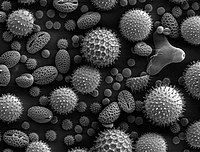
Photo from wikipedia
Abstract Purpose X‐ray imaging devices contain a collimator system that defines a rectangular irradiation field on the detector plane. The size and position of the X‐ray field, and its congruence… Click to show full abstract
Abstract Purpose X‐ray imaging devices contain a collimator system that defines a rectangular irradiation field on the detector plane. The size and position of the X‐ray field, and its congruence with the corresponding light field, must be regularly tested for quality control. We propose a new method to estimate how far the x‐ray field extends beyond the detector which does not require the use of external detectors. Methods A metallic foil is inserted perpendicularly between the source and the detector. A slit camera, a linear extension of a pinhole camera, is used to project onto the detector the fluorescence X‐rays emitted by the irradiated foil. The location where the fluorescence signal inside the camera vanishes is used to extrapolate the location of the field boundary. Monte Carlo simulations were performed to determine the optimal composition and thickness of the foil. A prototype camera with a 1‐mm‐wide slit was built and tested in a clinical mammography and digital breast tomosynthesis (DBT) system. Results The simulations estimated that a foil made of 25 µm of Molybdenum provided the maximum signal inside the camera for a 39 kVp beam. The boundary of the X‐ray fields in mammography and DBT views were experimentally measured. With the camera along the chest wall side, the measured field in multiple DBT views had a variability of only 0.4 ± 0.1 mm compared to mammography. A difference in the measured boundary position of 2.4 and –1.0 mm was observed when comparing to measurements with a fluorescent ruler and self‐developing film. Conclusion The introduced technique provides a practical alternative method to detect the boundary of an X‐ray field. The method can be combined with other testing methods to assess the congruence of the X‐rays and light fields, and to determine if the X‐ray field extends beyond the detector more than permitted.
Journal Title: Journal of Applied Clinical Medical Physics
Year Published: 2021
Link to full text (if available)
Share on Social Media: Sign Up to like & get
recommendations!